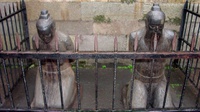tirto.id - Contoh soal IELTS (International English Language Testing System) dibutuhkan bagi para pendaftar beasiswa atau pekerjaan di universitas luar negeri, perusahaan multinasional, dan lain-lain.
Pada dasarnya IELTS merupakan ujian tes bahasa Inggris bagi orang yang ingin bersekolah, bekerja, atau tinggal di luar negeri. Calonnya mahasiswa yang perlu lulus ujian IELTS dahulu sebelum masuk di universitas negara berbahasa Inggris Britania seperti Inggris, Selandia Baru, atau Australia.
Ujian ini juga berlaku bagi mereka yang ingin bekerja di ketiga negara tersebut. Secara garis besar, ada dua jenis IELTS mencakup IELTS General Training dan IELTS Academic.
Pada IELTS General Training, orang-orang bisa mengikutinya jika ingin bermigrasi atau mengikuti sekolah menengah di negara lain. Sementara itu, IELTS diikuti oleh calon mahasiswa yang ingin bekerja di luar negeri.
Anda dapat mengikuti ujian IELTS dengan biaya sebesar 3-3,4 juta rupiah atau sekitar 215-240 Dollar AS.
Terkait sistem penilaian atau band score IELTS, mencakup 40 soal yang per soalnya dihitung 1 poin jika benar. Seandainya salah satu soal jawabannya tak tepat atau tak diisi, maka Anda kehilangan poin.
Kisi-Kisi Soal IELTS Reading Section
Berdasarkan catatan situs resmi IELTS, Reading Section Test IELTS mencakup 40 pertanyaan yang diwakili oleh tiga teks panjang.
Pertanyaan tersebut bisa meliputi pilihan ganda, mengidentifikasi informasi, mencocokkan informasi, fitur, judul, akhir kalimat, dan masih banyak lagi.
Secara khusus, jenis soal yang dibagikan kepada peserta IELTS General Training dan IELTS Academy berbeda.
Sebagai kisi-kisinya, IELTS General Training akan menyajikan beberapa soal terkait pengetahuan umum. Misalnya, membahas segala kegiatan yang terjadi di dalam kehidupan sehari-hari.
Sementara itu, IELTS Academy akan lebih rumit lantaran ditujukan untuk menyiapkan calon mahasiswa. Oleh karena itu, di dalamnya akan termuat soal perihal akademis seperti analisis dan riset.
Contoh Soal IELTS Reading Passage dan Jawabannya
Berikut ini contoh soal IELTS Reading Passage yang diterbitkan oleh situs IELTS USA (halaman 3-5).
Kamu harus membaca selama 20 menit pada paragraf berikut, kemudian jawab soal yang terdapat di bawahnya.
EXTRACTION AND PURIFICATION OF DRINKING WATER
Some consumers choose to purchase bottled drinking water, rather than relying on city tap water supplies. Bottled water has typically been extracted from underground sources. If water exists underground, but has no natural exit points, bottling companies may construct a water table well by drilling down to extract water from an unconfined aquifer. This is done when the Earth’s natural water level – known as a water table – is much lower than the Earth’s surface. In some cases, as with a valley or gully on a mountain, the level of the water table may be higher than the Earth’s surface, and a natural spring can emerge. Bottling companies are permitted to extract this water from a hole drilled into the underground spring, but the composition of the water must be identical to that of the naturally surfacing variety nearby.
Artesian water is drawn from a confined aquifer, a deep underground cavity of porous rock that holds water and bears pressure from a confining layer above it. This water can be accessed if companies drill a vertical channel down into the confined aquifer. Due to the pressurised nature of this aquifer, water will often rise up from within it and form a flowing artesian well, which appears as an explosive fountain at the earth’s surface. However, this only occurs when the surface is lower than the natural water table. If the surface is not lower than the natural water table, it is still possible to draw artesian water by using an extraction pump.
Some bottled water is advertised as ‘purified’, which means it has been subjected to a variety of different cleansing processes. A common filtering procedure, known as reverse osmosis, involves the water being pressed through microscopic membranes that prevent larger contaminants from passing through. The microscopic size of these holes is such that they can even obstruct germs, but they are most effective against undesirable materials such as salt, nitrates and lime scale. One disadvantage of reverse osmosis is that a lot of unusable water is generated as a by-product of the procedure; this must be thrown away.
For treating pathogens, an impressive newer option is ultraviolet (UV) light. Powerful UV light has natural antibacterial qualities, so this process simply requires water to be subjected to a sufficient strength of UV light as it passes through a treatment chamber. The light neutralises many harmful germs by removing their DNA, thereby impeding their ability to replicate. A particularly impressive quality of UV light is its ability to neutralise highly resistant viral agents such as hepatitis.
The overall effects of UV light treatment are variable, however, which leaves many municipal water treatment processes relying on chlorination. Its powerful and comprehensive antimicrobial effect notwithstanding, chlorination is also extremely inexpensive and remains the only antimicrobial treatment capable of ensuring water remains contaminant-free all the way through the pipes and to the taps of domestic homes. Many members of the public remain suspicious of water that has been treated with such a harsh chemical. Its ease of use and affordability has meant that chlorine often plays an important role in making tainted water supplies safe for consumption immediately after natural disasters have occurred.
Some water also undergoes distillation. This involves water being boiled until it converts to steam, which then passes through a cooling tube and becomes water again. Toxic compounds and impurities such as heavy metal residue are left behind in this process, so the steamed water is typically cleaner than the pre-distilled version. Unfortunately, distillation equipment also removes up to fourteen types of beneficial minerals that naturally occur in water. Consequently, those who rely on distilled water may need to take mineral supplements.
In developed countries, all forms of drinking water are typically subject to stringent quality control processes, so there is little evidence to suggest importing bottled water at significant expense will be safer or healthier than regular tap water from a municipal drinking supply. Both tap water and bottled water are tested for pathogens and contaminants and, aside from isolated cases related to issues such as faulty plumbing or old pipes, tap water is harmless. Nevertheless, many purchasers of bottled water still justify their choice on the quite reasonable basis that tap water has a distinctly unpleasant aftertaste related to the chlorination process it has undergone.
Soal:
Classify the following statements as referring to
A. reverse osmosis
B. UV light treatment
C. chlorination
D. distillation
Write the correct letter, A, B, C or D, in boxes 6–11 on your answer sheet.
NB: You may use any letter more than once.
- It continues to protect water as it is being transported.
- It is particularly useful during emergencies.
- It uses a physical barrier to separate unwanted matter from water.
- It prevents bacteria from reproducing.
- It removes all mineral particles.
- It produces a lot of waste water.
- C
- C
- A
- B
- D
- A
Penulis: Yuda Prinada
Editor: Yulaika Ramadhani












